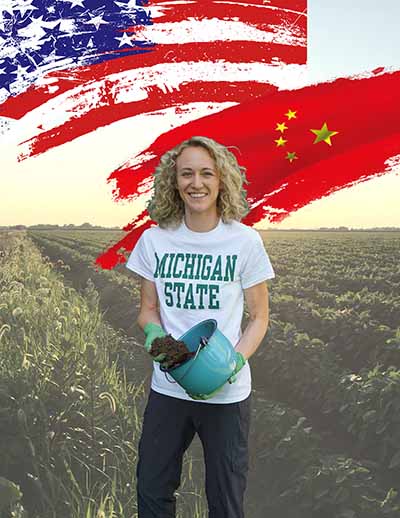Tariffs lead to creative supply chains
MSU scholars apply a new, more holistic way to examine global agricultural trade to better understand what’s going on when a country as enormous as China develops a big appetite for soybeans.

Where there’s a will to peddle soybeans in the global marketplace, there’s a way.
In the recent issue of the international open access journal Sustainability, Michigan State University (MSU) scholars apply a new, more holistic way to examine global agricultural trade to better understand what’s going on when a country as enormous as China develops a big appetite for soybeans.
In 2017, China imported 95.5 million metric tons of soybeans, worth nearly $40 billion — 67% of the world’s soybean supply. That trade comes with cascading economic and environmental consequences as countries change the way they use their land and natural resources to meet the demand.
Anna Herzberger, a PhD candidate and fourth-generation farmer from central Illinois, and her colleagues applied the integrated framework of metacoupling to understand the true extent of global soybean trade. The framework, which examines socioeconomic and environmental interactions within as well as between distant and adjacent places, allow researchers to consider input from a variety of disciplines, and then model interactions and reactions that can be compared to reality.
“In a time when international trade is being targeted by increased tariffs, it’s even more important to understand the true impact of these tariffs across the world,” said Jianguo “Jack” Liu, Rachel Carson Chair in Sustainability and director of MSU’s Center for Systems Integration and Sustainability. “We can’t understand the full impact – both socioeconomically and environmentally – of trade and trade restrictions until we look at the cascading consequences of production that is driven by internal, adjacent, and distant demands.”
The results, reported in “Telecoupled Food Trade Affects Pericoupled Trade and Intracoupled Production,” show that the perception that Chinese swelling demand for foreign soybeans plays out only in Brazil is a limited view. Brazil has displaced the United States as China’s top soybean importer. With that distinction comes more conversion of forestland to cropland or shifts from planting other crops in favor of soybeans.
But the MSU team shows the changes don’t end there. A closer look at the policies and planting decisions of neighbors show that some soybeans exported from Brazil were not grown in Brazil. Neighboring South American countries like Paraguay and Argentina restrict trading with China, yet their soybeans flow into Brazil as Brazil is shipping record amounts of soybeans to China.
“We’re masking the true extent of China’s demands when we only consider Brazil,” Herzberger said. “We need to consider that what Brazil export in fact in part comes from other countries, which in turn points us to greater impacts that extend to Brazil’s neighbors, even though some of those neighbors put in policies to avoid their  markets being driven by China’s market.”
markets being driven by China’s market.”
In addition to being part of a farming family, Herzberger has studied soybean farming practices in China’s primary agricultural region in the northeaster Heilongjiang Province. She comments on those two works in FromTheFarm.org.
In addition to Herzberger and Liu, the paper is by Kelly Kapsar, Min Gon Chung and Kenneth Frank. The work was supported by the National Science Foundation and MSU AgBioResearch. Metacoupling is an expansion of the telecoupling framework created by Liu and colleagues, to facilitate understanding the fast distant connections of the modern world.



 Print
Print Email
Email
